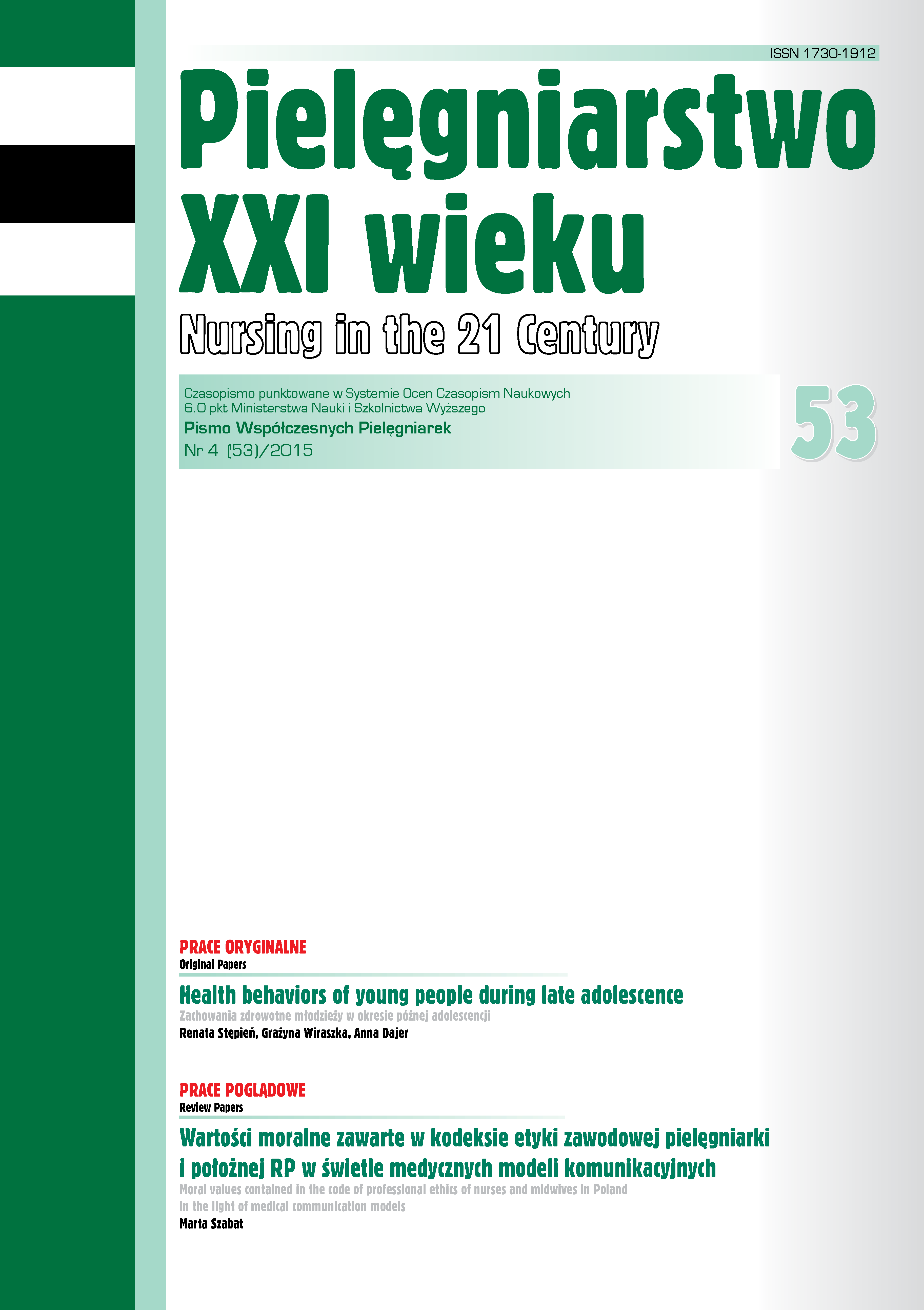Stress and interpersonal relationships in nursing work on the example of the study group
DOI:
https://doi.org/10.12923/p21w-2015-4/57Keywords:
nurses, stress, working environmentAbstract
STRESS AND INTERPERSONAL RELATIONSHIPS IN NURSING WORK ON THE EXAMPLE OF THE STUDY GROUP
Introduction. The working environment is full of stressful conditions that mainly concern the medical profession. In particular, the work of nurses is associated with high levels of occupational stress since they are responsible for helping, contacting the weak, sick or people that simply await medical assistance.
Aim. The aim of this study was to assess nurses’ exposure to stress at work.
Material and Methodology. The study involved a group of 108 nurses working in different entities of therapeutic activity in Sandomierz. The authors used the diagnostic survey method and a digital questionnaire of their own making. For statistical analysis, they used ANOVA Kruskal-Wallis test for multiple comparisons and medium-rank test for indicators of structure.
Results. As many as 82.72% of the surveyed nurses considered their work as stressful. The nurses mention the following factors as the most stressful ones: huge responsibility, low wages, exposure to harmful agents and dying people. The test results (p <0.001) indicate that not all of the tested stressful situations in the work environment of nurses evoke the same level of stress. Looking through the statistical lens, work induces stress in the following way: it causes pain, constant fatigue and irritability and lack of patience.
Conclusion. Among the stress factors at work, the nurses mention low wages and insufficient number of staff when set against the actual patients’ needs. Occupational stress exerts huge influence over the life of the surveyed nurses’.
References
1. Bugdol M. Wartości organizacyjne. Szkice z teorii organizacji i zarządzania. Kraków: Wydawnictwo Uniwersytetu Jagiellońskiego; 2006.
2. Kieżun W. Sprawne zarządzanie organizacją. Warszawa: Szkoła Główna Handlowa; 2008.
3. Mikołajczewska W. Znaczenie satysfakcji z pracy oraz czynniki ją warunkujące. Zeszyty Naukowe Gdańskiej Wyższej Szkoły Administracji. 2007; 2: 5.
4. Janowska Z. Zarządzanie zasobami ludzkimi. Warszawa: Polskie Wydawnictwo Ekonomiczne; 2002.
5. Lenartowicz H. Praktyka pielęgniarska uzasadniona naukowo. I Podlaska Konferencja Naukowo-Szkoleniowa, Pielęgniarstwo we współczesnej medycynie. Białystok: AM; 2000.
6. Kowalczuk K, Krajewska-Kułak E, Jankowiak B, i wsp. Zagrożenia zawodowe pielęgniarek, położnych i lekarzy w środowisku pracy. Problemy Higieniczno-Epidemiologiczne. 2008; 89 (2): 11.
7. Winecka-Jakubowska A, Włodarczyk D. Psychologia w praktyce medycznej. Warszawa: Wydawnictwo Lekarskie PZWL; 2007.
8. Kunecka D, Kamińska M, Karakiewicz B. Analiza czynników wpływających na zadowolenie z wykonywanej pracy w grupie zawodowej pielęgniarek. Badanie wstępne. Problemy Pielęgniarstwa. 2007; 15: 192-196.
9. Widerszal-Bazyl M. Pielęgniarek polskich portret własny z Europą w tle, czyli raport z badań europejskiego projektu NEXT. Warszawa: Centralny Instytut Ochrony Pracy – Państwowy Instytut Badawczy; 2004.
10. Skorupska-Król A, Szabla A, Bodys-Cupak I. Opinie pielęgniarek na temat czynników stresogennych związanych z ich środowiskiem pracy. Pielęgniarstwo XXI wieku. 2014; 1 (46): 23-26.
11. Perek M, Kózka M, Twarduś K. Trudne sytuacje w pracy pielęgniarek pediatrycznych i sposoby radzenia sobie z nimi. Problemy Pielęgniarstwa. 2007; 4: 223-228.
12. Sowińska K, Kretowicz K, Gaworska-Krzemińska A, i wsp. Wypalenie zawodowe i satysfakcja zawodowa w opinii pielęgniarek. Problemy Pielęgniarstwa. 2012; 20 (3): 361-368.
Downloads
Published
Issue
Section
License
Copyright (c) 2015 Kazimiera Zdziebło, Renata Stępień, Marzanna Siudak (Autor)

This work is licensed under a Creative Commons Attribution 4.0 International License.




